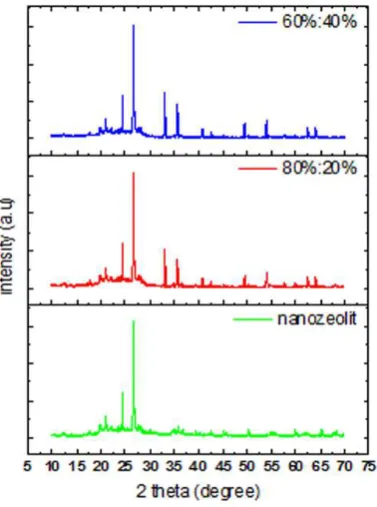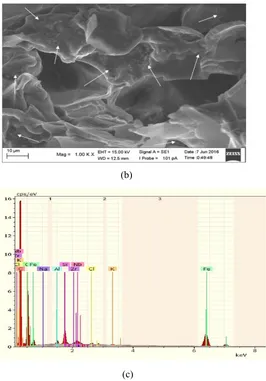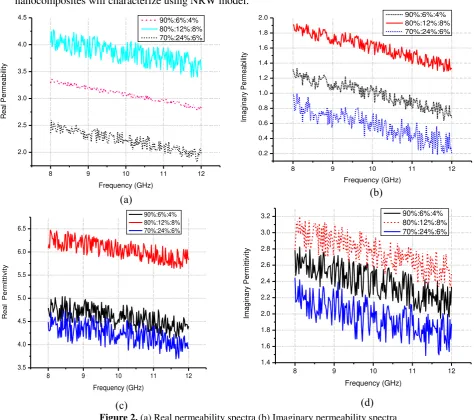PAPER • OPEN ACCESS
Effects of natural zeolite and ferric oxide to
electromagnetic and reflection loss properties of
polyurethane nanocomposite
To cite this article: G Gultom et al 2017 IOP Conf. Ser.: Mater. Sci. Eng.223 012031
View the article online for updates and enhancements.
Related content
Determination of Surface Energy of Natural Zeolite by Inverse Gas Chromatography
Ceyda Bilgiç and Naile Karakehya
-Effect of natural zeolite and kaolin as a catalyst in the isothermal-catalytic cracking of real municipal solid waste (MSW) for bio-oil production
I M Gandidi, M D Susila and H Rustamaji
-Synthesis and simultaneous self-assembly of novel antibacterial polyurethanes J H Duan, F Yin and G C Jiang
Effects of natural zeolite and ferric oxide to electromagnetic and reflection
loss properties of polyurethane nanocomposite
G Gultom1,2, B Wirjosentono3, M Ginting4, K Sebayang5
1 Polytechnic of Chemical Industry Technology, Medan, Indonesia
2 Physics Post Graduate Department, University of Sumatera Utara, Medan, Indonesia 3 Chemistry Department, University of Sumatera Utara, Medan, Indonesia
4 Research Center for Physics, Indonesian Institute of Science, Serpong, Indonesia 5 Physics Department, University of Sumatera Utara, Medan, Indonesia
E-mail : [email protected]
Abstract. Microwave-absorptive polymeric composite materials are becoming important to
protect interference of any communication systems due to increasing use of microwave-inducing devices. In this work, the microwave-absorptive polyurethane nanocomposites were prepared using natural zeolites of Sarulla North Sumatra and commercial ferric oxide as fillers. Weight ratios of the polyurethane to natural zeolite and ferric oxide were varied (90%:6%:4%; 80%:12%:8%; 70%:24%:6%) by weight. The fillers were prepared using ball milling technique and characterized for their particle size distributions using Particle Size Analyzer. The nanocomposites, prepared using in-situ reaction of polyethylene glycol, toluene diisocyanate and fillers. The complex permittivity (’and ’’) and complex permeability (’ and ’’) as electromagnetic properties were calculated using NRW method after collecting real and imaginary S parameter using Vector Network Analyzer measurement at X band frequency. Results show ratio of the fillers will affect the permeability, permittivity and reflection loss of the materials. The best reflection loss was shown -40.588 dB (>99 % absorption) at ratio for polyurethane : nanozeolite : ferric oxide (80%:12%:8%) by weight observed at 10.92 GHz. According to the measurement and calculation was shown the polyurethane filled with natural nanozeolite and ferric oxide is a good electromagnetic wave attenuation material.
1. Introduction
The electromagnetic interference, a specific type of interference environmental pollution, is
worsening due to the rapid development and utilization of wireless communications circuit devices
and military applications. In the past decades, electromagnetic attenuation materials which comprise
dielectric or magnetic fillers and polymer, have been commonly used to minimize the electromagnetic
interference. The spinel ferrite have been utilized as the most frequent absorbing materials in various
forms. The absorbing characteristics of materials depend on the frequency, layer thickness, complex
permeability and complex permittivity. All the real and imaginary parameters of complex permeability
and complex permittivity are found to increase with the increased of ferrite contents [1].
Zeolite mineral is a compound of aluminium silicate hydrate with alkali metal which is group of
occupied by a large ions and water molecules, both of which have considerable freedom of movement,
permitting ion-exchange and reversible dehydration. Natural zeolite is natural mineral that composed
of crystalline silica (SiO2) and alumina (Al2O3), with cavities of metal ions, which is usually alkali and
alkaline or earth metals, and water molecules. Unique characteristic, include very stable with very
high adsorption capacity and selectivity and have large active pore structure (microporous) and has a
high specific surface area. Natural resources have the potential to be further processed into products
that can be used for broad applications, among others, as supporting the catalyst or catalysts, and slow
release substances. Zeolite crystal structure of alumina silicate shaped frame (framework)
three-dimensional, having cavities and channels as well as containing metal ions such as Na, K, Mg, Ca and
Fe as well as water molecules. Sarulla natural zeolite chemical composition analysis using XRF
showed the dominant chemical compounds are SiO2 and Al2O3.
Usually, ferrite composites are used to achieve microwave absorption. The absorbing
characteristics and electromagnetic characteristics could be varied by controlling the ferrite filler
volume fraction in the composite materials [2]. Studies of either nanoparticles or core-shell
nanopowders such as carbonaceous particles and polyurethane as matrix for the application in
microwave absorbers were very interesting in the last decades [3,4,5]. However, studies of using
nanozeolite as a filler for microwave-absorptive materials were very limited.
In this paper, with the aim finding high microwave absorption in GHz range filled with
nanozeolite as an abundant local natural resources and ferric oxide with its strong magnetic
characteristic were prepared. We investigate electromagnetic properties and the reflection loss
properties due to nanofillers variation of weight. Our experimental results highest reflection loss was
-40.588 dB at 10.92 GHz and as the result is polyurethane filled with nanozeolite and ferric oxide are
promising for microwave-absorptive materials.
2. Materials and Methods
The fillers used for nanocomposite was Sarulla natural zeolite and Sigma Aldrich commercial
ferric-oxide (α-Fe2O3) with 99.95% purity. The polyurethane matrix used was Sigma Aldrich
commercial type which contains two-part monomers i.e. 60% wt polyethylene glycol has a density
1.01 g/mL and 40% wt toluene diisocyanate has a density 1.22 g/mL.
The polyurethane nanocomposites reinforced with natural nanozeolite and ferric-oxide were
fabricated with in-situ reaction. The activated natural zeolite prepared using planetary ball mill for
28 h to complete nanozeolite with average particle size distribution < 100 nm. Nanozeolite mixed for 4
h with ferric oxide using planetary ball mill to produce nanofillers. The homogen nanofillers divided
into the same ratio and mixed with PPG and TDI for 1 min. Polyethylene glycol and toluene
diisocyanate with nanofillers of zeolite and ferric oxide are using in-situ reaction. Both of PPG and
TDI with nanofiller mixed for 2 min with in-situ reaction at room temperature. The reaction of PPG
and TDI and nanofillers polyurethane nanocomposites filled with nanozeolite and ferric oxide is hold
and pressed for 30 min using iniversal testing machine with 5 mm sample thickness.
The crystal structure of the samples were determined by Shimadzu-700 X-ray Diffractometer
(XRD) using Cu Kα radiation (λ = 1.54 Å) operated at 35 kV and 25 mA. The reflection loss of the
samples was measured between 8 GHz and 12 GHz using Vector Network Analyzer Advantest type
R 3770 and microstructure of the samples using SEM-EDX Carl Zeiss-Bruker Type MA10.
3. Characteristic of Product
Figure 1.a shows the X-Ray Diffraction spectrum of Sarulla natural zeolite. Observed from the
XRD spectrum shows intensity at 2θ = 29.76; 27.67 and 27.92. Maximum peak occur at 29.76 with FWHM 0.124 which is at the aluminium silicate phase. Mordenite standard have a high intensity at 2θ
= 27; 25.63 and 23. Compare with Sarulla zeolite, it shows that natural zeolite is mordenite, but
another peak at natural zeolite at 29.76 shows that crystaline at Sarulla natural zeolit is not only
modernit but also mixed with other crystalline and other impurities. Combination of filler varied of
nanozeolit and ferric oxide with ratio (80% : 20%) and (60%:40%) by weight, observed from the XRD
spectrum shows another high intensity at 2θ = 33.121 and 35.60, which is not occur at the nanozeolite
Figure 1. (a) XRD pattern of natural zeolite (b) SEM photograph of polyurethane nanocomposite (c) EDX polyurethane nanocomposite characterization
From Figure 1.b SEM photograph of polyurethane nanocomposite shows that dark colors are pores or
cavities and bright color is polyurethane matrices and arrows show the occurance of agglomeration
caused by nanozeolite and ferric oxide. Results of other studies suggest that the materials properties
will be compatible with the polymer matrices and influenced by several factors such as filler particle
size. The particle size will affect the bond of the filler and the matrix. The amount of surface area will
be increased by the presence of a surface porous on the fillers surface as well as with the addition of
natural nanozeolite and ferric oxide. Figure 1.c show EDX polyurethane nanocomposite
characterization. According to the EDX characterization it was shown that the agglomeration is the
effect of the fillers.
(b)
(c)
8 9 10 11 12
Characterization of electromagnetic wave absorption was carried out with a Vector Network
Analyzer. From the scattering parameters S11 and S21 measured by the coaxial method using VNA in
the frequency range of 8 - 12 GHz, the relative complex permeability r ( = r’ - jr’’) and the relative
complex permittivity r ( = r’ - jr’’) were calculated using Nicholson Ross Weir model. The
electromagnetic properties which is dielectric and magnetic properties of polyurethane
nanocomposites will characterize using NRW model.
Figure 2. (a) Real permeability spectra (b) Imaginary permeability spectra (c) Real permittivity spectra (d) Imaginary permittivity spectra
From Figure 2 above show how variation of the filler affect the permittivity and permeability of the
polyurethane nanocomposite. It is observed that in the lowest frequency region the polyurethane filled
with nanozeolite and ferric oxide shows the larger value of real and imaginary for both permittivity
and permeability. Dielectric constants depends on two factors, orientation and interfacial polarizations.
(a) (b)
In case of polyurethane nanocomposite (80%:12%:8%), the orientation and interfacial polarizations
should be high due to ferric oxide. The variation of both real and imaginary parts of permittivity with
frequency may be happen due to space charge polarization. Polar-polar reaction between polyurethane
and the fillers probably will affected the demagnetizing field. The demagnetizing field generated by
the magnetic poles on the surface of magnetic fillers plays a very important and characteristics role in
the permeability of material. Both ’ and ’’ shows decreasing trend with increasing of frequency, due
to the lower resonance frequency range of the polyurethane nanocomposite. The fluctuation of the
permittivity and permeability spectra caused by the pores of polyurethane nanocomposite. As a
confirmation for the other research it was shown that trends of permittivity spectra was observed that
in the lowest frequency region shows the larger value of real and imaginary permittivity [5].
The enhanced ’ and ’’ values will improve the microwave absorbing effect by transferring
electromagnetic energy into heat energy. Magnetic losses, as the important phenomena in absorptive
materials, are caused by the time lag of the magnetization vector behind the magnetic field vector [6].
The change of the magnetization vector is generally brought about by rotation of the magnetization or
the domain wall displacement. These motions lag behind the change of the magnetic field and
contribute to ’’. The smaller the particle size, the weaker the spins coupling at the surface of the
nanozeolite and ferric oxide, which makes the magnetic relaxation behaviour more complex.
The magnetic and dielectric particles filled into the polyurethane matrix can act as a large
number of charge domains and can contribute to increase the dielectric constant values due to
interfacial polarization [7]. The dielectric loss mechanism occur due to the permanent and dominant
polarization and their associated relaxation phenomena. The nanocomposite materials showed the
microwave absorption properties according to their dielectric loss values. Polyurethane filled with
nanozeolite and ferric oxide (80% : 12% : 8%) have better dielectric loss value than other
nanocomposites and it achieved better microwave absorbing properties.
Reflection loss measurement using Vector Network Analyzer for polyurethane nanocomposites
reinforcement with ratio of polyurethane : nanozeolite : ferric oxide = (90% : 6% : 4%); (80% : 12%:
8%) and (70% : 24% : 6%) by weight as a function of frequency in X-band (8-12 GHz) shows in
Figure 3. Polyurethane nanocomposites with ratio (80% : 12% : 8%) have the optimum reflection loss
of -40.588 dB at 10.92 GHz. The reflection loss of less than -40 dB means the microwave absorption
more than 99% [8]. The microwave absorption being dependent on the ratio of SiO2 and Al2O3 which
is to dominant compounds of natural zeolite and ferric-oxide, the content of ferric-oxide in natural
zeolite will modify the reflection loss and microwave absorption of the nanocomposite and will affect
the complex permittivity and complex permeability of the nanocomposite. To satisfy the
zero-reflection condition where maximum absorption would occur. Ferrite itself usually present
electromagnetic characteristics of complex permeability less than complex permittivity. Minimum loss
occurs when the thickness is about an odd multiple of one quarter of the wavelength of the incident
frequency.
Figure 3. Reflection loss measurement of polyurethane nanozeolite and ferric oxide nanocomposites
5. Conclusion
Natural zeolite and ferric oxide ratio as a filler in polyurethane matrices will modify
permeability and permittivity of the nanocomposite, by the addition of the the filler will cause a
different effect in electromagnetic properties and microwave absorption due to material reflection loss.
The nanocomposite absorb microwave at X band frequency for > 99 % absorption. This is due to the
effect of aluminum silicate and ferric oxide binding with polar - polar reaction between filler and
matrices. These reaction cause difference in input impedance and this will make a difference in the
resonance at high frequency. Ferrite-oxide particle have a great microwave absorption characteristic,
but in this case, the ratio between zeolite and ferric-oxide will affect the best microwave absorption.
The unique properties of nanozeolite and polyurethane provide an important foundation for developing
the materials with strong microwave absorption in wide applications prospects.
References
[1] Abbas SM et al 2006 Composites :Part A 37 2148-2154. [2] Kong I et al 2010 J Magnetism Magnetic Mat 322 3401-3409. [3] Peng C H et al 2004 J. Magnetic Mater284 113-119.
[4] F. Qin and C. Brosseau 2012 J. Appl. Phys 111, 061301.
[5] Esfahani et al 012 Preparation and Characterization of Foamed Polyurethane/Silicone Rubber/Graphite Nanocomposite as Radio Frequency Wave Absorbing Material : The Role of
Interfacial Compatibilization, J. Compscitech.
[6] Pawar R P et al 2013 Proc. and Appl. Ceramics7 [1]: 1-7. [7] Jamal E.M et al 2009 Mater. Sci. and Eng. B156 24-31.



